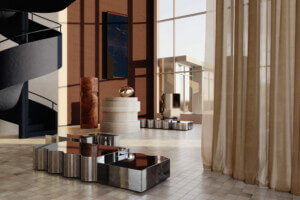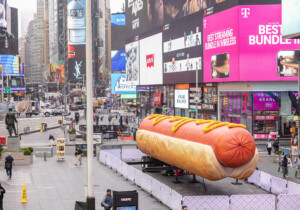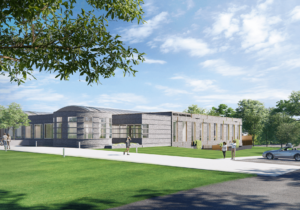ED RUSCHA / NOW THEN
MoMA
Through January 13
Ed Ruscha’s Every Building on the Sunset Strip (1966) is an accordion book that consists of two paired, long elevations of the Sunset Strip in Los Angeles. The photos and street names are pushed to the top and bottom of the paper, leaving a blank zone in the middle. To make the piece, the artist mounted a camera on the bed of his pickup truck and documented a mile and a half of street frontages. The work is a precedent that, across half a century of architecture studios, has launched a thousand site context drawings: The students of Robert Venturi and Denise Scott Brown quickly “imitated” it when studying the Las Vegas Strip. (It was thought that Ruscha might’ve attended the final review for the Learning from Las Vegas studio in 1968, but Scott Brown denied this appearance, according to Jesús Vassallo’s Epics in the Everyday.) The book, its bellows extended and enclosed in a leggy vitrine, appears early on in ED RUSCHA / NOW THEN, the exhibition that functions as both a thorough retrospective and the artist’s first solo show at the museum. (Ruscha is a youthful 85.) It comes down soon on MoMA’s sixth floor before its summer run at LACMA starts in April.

Close to the accordion book, a copy of Ruscha’s Twentysix Gasoline Stations dangles on a wire. Measuring 5 by 7 inches, it reproduces photos of its subjects as they appeared along U.S. Route 66, an inspirational highway for Ruscha, a Nebraskan by way of Oklahoma City who landed in Los Angeles in 1956. Other publications and ephemera appear across the galleries, including Royal Road Test, a spiral-bound item from 1967 that documents the results of a typewriter tossed from a moving car. Then there’s Various Small Fires, Some Los Angeles Apartments, Nine Swimming Pools and a Broken Glass, and the list goes on. These publications are incredible, and so dry.

Ruscha’s books inspired a sizable army of imitators, as documented in the meta-book Various Small Books. His books alone would be cause for celebration, but he created so much more art. Ruscha’s gaze—long praised for its deadpan, quotidian, everyday sensibility—unlocked new rooms in the postwar American psyche for artistic exploration. His genius was in the conversion of banal cultural elements—from supermarkets to billboards, landfills, and popular music—into brilliantly dumb, deeply flat pieces that sing because of how little there is to them. Ruscha converts the barrage of word-salad phraseologies one encounters during daily life into nonsensical canvases that mix text, gradients, and objects. Who else can paint three letters in yellow on a blue background—Spam colors—and repackage it into a gutpunch like OOF?

Ruscha’s education and early work as a commercial artist gave him the technical abilities to reproduce the norms of mass communication. Advertisements sublimate into art; he could ape the genre because he knew its devices. Rancho (1968) spells the word in honey-colored liquid against a sunset-gold backdrop, like a marketing shoot outtake. At the time, Ruscha was working for Artforum as a production designer and art director for editor Philip Leider. (He used the pseudonym “Eddie Russia.”) The September 1966 special issue of Artforum dedicated to surrealism included a soapy cover by Ruscha/Russia. Soon after, he delivered a Rancho-toned cover for Mason William’s kitschy country record Music. (Both items are on view in MoMA’s retrospective.) The latter marks Ruscha’s rare foray into album art until recently, when he began doing covers for Paul McCartney, a limited-edition 2pac reissue, and the Beatles’ final song, “Now and Then,” released late last year. Many aspects of contemporary living owe an aesthetic debt to Ruscha, from fast fashion to internet memes to Google Street View.

There is much for architects to love in ED RUSCHA / NOW THEN, from the pencil drawings of apartment buildings and 3D-rendered-shadow words—like something out of an introduction to drawing course—to the later Course of Empire series, produced for the 2005 Venice Art Biennale, which revisits an earlier series of two-point–perspective warehouse scenes he did, with a neoliberal update. The show includes one of Ruscha’s earliest works, Parking Lines (1951), which showcases linework cars in plan, with some paint-bucketed in. In his chapter “Inclusive Surfaces,” Vassallo explores the influence of Ruscha on Venturi and Scott Brown namely in their development of a “non-judgmental attitude:” Ruscha’s interest in L.A.’s “facadedness”—his term—resonated with architects who sought to see the world around them in an unprejudiced, flattened way. Plus, the retrospective displays the epic, wide-angle painting of LACMA on fire, which will be a fun one for Angelenos to ponder inside that same museum later this year.


As Jackson Arn observed, the show sags in the middle, when large, inky, out-of-focus scenes go nowhere. But then, Ruscha’s back, and his amazing mountain prints take over: PAY NOTHING UNTIL APRIL, knocked out of an alpine peak, is a welcome shout. There’s also a gallery where his only installation, realized in Venice, Italy, in 1970, is recreated: Four walls of chocolate-printed-on-paper shingles make good on the piece’s name, Chocolate Room. It’s cute and aromatic but not much else. Finally, politics seep in at the end: The last and latest canvas one sees when exiting the show is an American flag disintegrating into a black background.

I found it productive to see this show together with Emerging Ecologies, on view in MoMA’s architecture gallery, as both traffic in the same era of American popular culture. As such, both carry latent messages about petromodernity: Ruscha explicitly explores its proliferation—gas stations, car culture, sprawling suburbia, even the polychromatic reflectivity of new petrochemical materials—and diverts its machismo into conceptual stunts (AN EXHIBITION OF GASOLINE POWERED ENGINES, roars one later piece.) Ecologies, meanwhile, showcases efforts to escape the paradigm through low and high means, ranging from self-built Earthships to worldmaking supported by big-government dollars.

The editor William Germano defines a writer as a “great pair of ears with adequate typing skills;” Ruscha is a great pair of ears with excellent painting skills. His transmogrification of language might be the most enduring aspect of his artistic practice. He has carved out a distinct conceptual space where the image, geometry, and meaning of language is explored. Among a grid of his smaller word-paintings is one that declares, à la Rolling Stones, “I don’t want / no retro / spective.” Doesn’t matter, bub—you’ve earned it.










